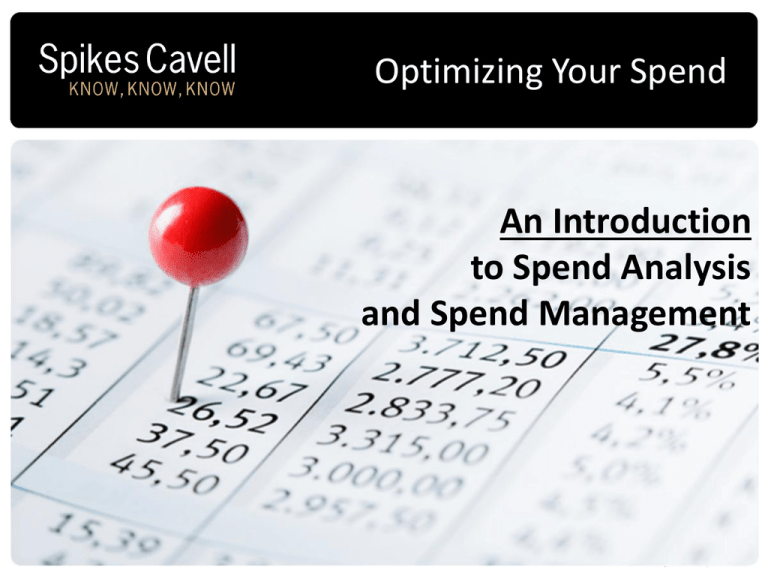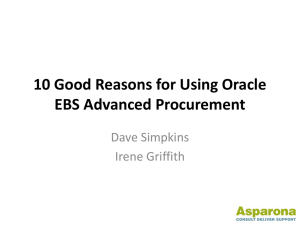Spend Analysis
advertisement

Optimizing Your Spend An Introduction to Spend Analysis and Spend Management Spend Analysis and Spend Management • What are they? • Who uses them? Who are they relevant to? • Why bother? • How are they done? • What does the Spend Analysis process look like? • What spend management projects could I undertake after a spend analysis to identify savings? In the name of transparency… Let’s agree on a few things first… Do you trust your current YouWhat already do have you call thespend raw data data to Ask answer procurement questions in your outside AP, FMS, of contract? ERP systems questions? What are they? Spend Management: Spend Analysis: What you do with the What you do to the data… data… Spend Analysis AP Data PO Data pCard Data Cleanse Spend Data Classify Enhance Spend Management Improve Processes Manage Maverick Spend Manage Supplier Relationship Manage Risk Recover Overpayments Procure Cooperatively Reduce Disparity Source More Locally Ensure Legal Compliance Benchmark Relative Position Quantify Savings Deliver Savings Spend Data Spend Analysis 84.4% Spend Management Buyers Budget Holders Audit Department Procurement Managers Spen Spend d Data Data Legal Department Contract Managers Finance Department Accounts Payable Economic Development Equality Officers Environmental Officers Why bother? Challenges Obstacles Cut spending but not services Incomplete and poor quality data Collaborate within and Multiple poorly integrated systems across sectors Local/ Small/ Diverse/ Sustainable Suppliers Be transparent No standard FMS implementation Time and support Why bother? Solutions Software Data Guidance AP system tools Spend Analysis Provider Customized consultancy project E-Procurement Hire a Data Analyst / Excel or Access Expert Analytics/ BI tools How is spend analysis done? 1. Supplier name 2. Supplier address Invoice of number 53. Pieces Data 4. Invoice date 5. Spend value How is spend analysis done? DIY Export from AP, pCard and PO systems Sense check exports Stitch exports together Manipulate in Excel, Access etc. Enhance data on top 25 suppliers Manually classify suppliers How is spend analysis done? External Export from AP + pCard + PO Systems Standardize exported data Check fitness/ accuracy of data export Manually validate classification Classify to common taxonomy De-duplicate supplier records Validate value and volume with organization Enhance supplier information Link to a master record Provide MI tools and export function Spend Data Common Pitfalls • Assuming classification is easy • Assuming data can be stitched together • Assuming software can do it for you • Finance or IT teams too busy to extract • Data extracted incorrectly and not checked • Relying on user entered classifications • Existing tools are designed for analysts Using the results of spend analysis The 10 Point Plan Invoice Consolidation 1 Long Tail Consolidation 2 Duplicate Payments 3 Improved Terms 4 Category Extension 5 Category Rationalisation 6 Compliance, Contracted Suppliers 7 Cooperation, Common Suppliers 8 Price Variance 9 Category 10 Reengineering Example Savings Opportunity If I could answer these questions, I could find savings… If I want to answer those questions, this is the data I need… Invoice Reduction • Which suppliers should I seek weekly/monthly invoices from? Aggregate number of invoices per supplier • Which category of suppliers are giving me an invoice volume problem? • Which suppliers would be best to move order and payment to pCard? • How much could I save by moving to pCard? Supplier Names Average invoice value per supplier $ Invoices by value range per supplier 43,979 invoices < $500 Long Tail Consolidation • Which suppliers do I spend less than $1000 per year with? • Which suppliers do I only have one transaction with per year which I could lose? • Which departments are using a lot of “one time” suppliers? • Which categories do we have a lot of small suppliers in? Aggregate spend per supplier Supplier Name Aggregate number of invoices per supplier $ Category of supplier Department spend per supplier 1829 suppliers < $1000 Terms in the Top Tier Identifying Savings: • Which suppliers do I spend the most with and how many departments do they supply? • How many other suppliers are in the same category as my top tier suppliers? • Are all of my departments getting the same “best rate?” • How much do my top tier suppliers rely on my business? Category of supplier Department spend per supplier Aggregate spend per supplier (deduplicated) Supplier Name Other suppliers in the same category Percentage of supplier’s turnover represented $ Contracts already in place 84 suppliers > $250k Contract Compliance Identifying Savings • Which departments aren’t using the preferred/ contracted supplier in a given category? • Which categories of spend don’t have any contracts in them? • Is my data source up to date enough to deal with offcontract spend quickly? Category of supplier Other suppliers in the same category Aggregate spend per supplier Supplier Name Dept. spend per supplier Current contracts Categories with no contracts $ Monthly spend information 36% average with contracted suppliers Category Rationalization / Extension Identifying Savings: • Which suppliers enjoy a relative monopoly of supply to my organization? • Which categories do I have too many suppliers in where aggregation could drive costs and prices down? • What contracts are coming up for renewal where I could rationalize or extend my supplier base? Other suppliers in the same category Category of supplier Aggregate spend per supplier Supplier Name Department spend per supplier $ Current contract expiry date 44 Sporting Goods Suppliers Aggregation with other organizations …where are the opportunities to collaborate with other public sector bodies? Identifying Savings: • Which suppliers does my group already share and how much is spent with those suppliers? • Which categories does the group have the greatest spend/ greatest number of suppliers? • When are the current contracts for members of the group expiring so that we can collaborate? Aggregate spend per supplier) Category of supplier to common classification Standardized public sector body name/number Standardized supplier name/number Current contract expiry date Centrally hosted and maintained database $ Common tools that all contributors can use 18 Suppliers, $38m aggregate spend Next Steps: • Spend Analysis really is the first step • Get the data in shape first • Internal or External • Start thinking about problem areas • Let the data guide your projects • Analytical/business intelligence tools are step two. • A Spend Management plan is step three. Spend Analysis and Spend Management The images, charts, and graphs in this presentation were exported directly from the NIGP Observatory. For more information about how the NIGP Observatory could help your agency to identify real savings, collaborate more effectively, increase contract compliance, and record your success, please contact Spikes Cavell, NIGP’s strategic partner: Jonathan White: (571) 527 - 8310 jonathan.white@spikescavell.net






